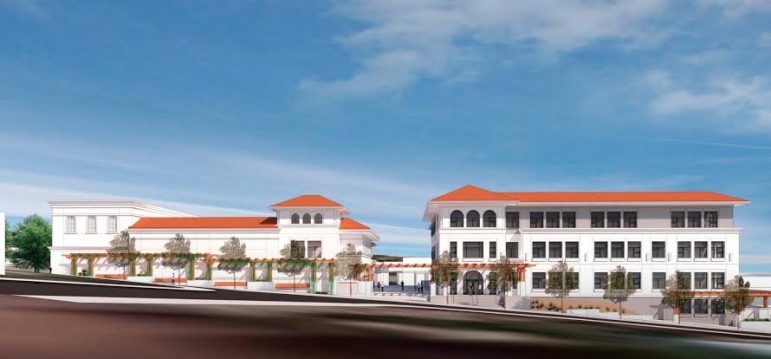 The district is in the process of finalizing budget plans for the upcoming H1 Bond Measure projects, including the construction of a new STEAM building and the renovation of Witter Field, both of which are scheduled to begin in March, H1 Program Manager Pete Palmer said.
The district is in the process of finalizing budget plans for the upcoming H1 Bond Measure projects, including the construction of a new STEAM building and the renovation of Witter Field, both of which are scheduled to begin in March, H1 Program Manager Pete Palmer said.
Construction plans and designs for the new STEAM building have already been completed and sent to the state for review. Budget plans, however, will not be finalized until December, Palmer said.
“What we’re trying to do is get a guaranteed maximum price for the cost of the new STEAM building, the cost of the new theater, and the renovation of Witter Field,” Palmer said.

Palmer said that the guaranteed maximum price (GMP), or the final budget for all of the H1 projects, will be determined by the district’s chosen contracting company, Overaa. Contractors will evaluate the GMP using a comprehensive set of pre-arranged specifications and plans. The district expects to receive bid estimates from Overaa before the last board meeting in December.
“It’s a little nerve-wracking right now until we get the guaranteed maximum price,” Palmer said. “We just have estimates right now, and the initial estimates that we’re getting are pretty high.”
Based on the quantity and the scope of planned renovations and constructions, the total cost of the H1 Bond Measure projects could be as high as $140 million, exceeding the $66 million budget, Palmer said.
Despite these potentially high estimates, Chief Financial Officer Ruth Alahydoian said that the district hopes to contain the budget to the amount provided by the H1 Bond.
“Right now we’re planning to work within H1,” Alahydoian said. “We’re designing with the expectation that whatever we plan will get covered by H1.”
However, given the current economic climate, the district is currently building in room for error in their estimations, said School Board Vice President Amal Smith.
Palmer said that the district had originally planned on paying $530 per square foot of construction in the new STEAM building, but this value is now subject to fluctuation.
“We now have tariffs with China that impact the cost of steel. The fires last year in Sonoma impact the ability to get building materials,” Smith said. “You can predict the cost on the conditions at the time and even build in factors for unknowns, but you still have to go back and adjust.”
According to a memo released by the district on Oct. 1, there is also no guarantee that the State will approve the pending construction plans, which may alter both the construction schedule and the budget.
“It is uncertain when the State will issue permits for these projects,” the memo said. “The actual schedule will depend on [whether or not the State will approve the plans] and other factors such as general and subcontractor availability, lead-times for procurement of materials, and weather conditions.”
In addition, although the district is working to stay within budget, Smith said that they also hope to receive extra funding to ensure that all construction can be carried out smoothly regardless of external circumstances. According to the Measure H1 website, the district is eligible to receive between $4.8 million and $6.47 million in state funds.
“We’re hoping to get money from the state, but only if those funds are released,” Smith said.
The district is also looking to reduce costs by locating and salvaging existing infrastructure, a process known as potholing. Creating potholes around Alan Harvey Theater before the planned demolition during Spring Break will identify usable facilities in order to protect them from damage, Palmer said .
“The only facility that’s going to be new is electric service,” Palmer said. “We’re going to reuse everything else, including sewer, storm, domestic, fire, irrigation water, fiber, optics, phone, and cable services.”
Based on the results from similar techniques used during the renovation of Havens Elementary School, Palmer said reusing infrastructure could save the district a significant amount of funding.
“We could save $500,000 to $700,000 in total,” Palmer said.
Beyond short-term savings like potholing, Palmer said that the long-term savings from the new energy-efficient buildings will reduce both the district’s costs and its carbon footprint.
“These [buildings] will be zero net energy buildings. With photovoltaic panels on the roofs and above the windows for shades, we will be able to provide more power than the buildings use,” Palmer said. “We signed an agreement with PG&E to sell the [excess] power back to them. This means we could actually be generating income, especially during the summer when there’s not very much usage.”
Planning large-scale renovations within a limited budget ultimately compels the construction planners to think about durability over superficial features.
“The budget is what restricts you to focus on what’s really important. It forces you to think about energy-efficiency and the quality of materials,” said Alahydoian. “We want to do everything thoughtfully, looking not just for what’s flashy today, but for what’s going to last for a long time.”

Visit TPHnews.com to read more from The Piedmont Highlander.